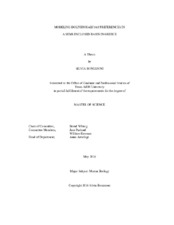| dc.description.abstract | Information on the distribution and habitat preferences of a species or population can be used to assess its status and identify appropriate management action. This is particularly relevant in areas exposed to high human impact, such as the coastal and inland waters of the Mediterranean Sea. The Gulf of Corinth is a 2,400 km^2 semi-enclosed embayment in central Greece, characterized by waters up to 900 m deep. This study focuses on the two most abundant odontocete species occurring in the Gulf: striped dolphins Stenella coeruleoalba and common bottlenose dolphins Tursiops truncatus. Boat surveys totaling 21,435 km were conducted between 2011 and 2015, yielding 1,873 km of group follows for striped dolphins and 336 km for bottlenose dolphins. Dolphin distribution was investigated by incorporating multiple geographic, bathymetric, environmental and anthropogenic variables in generalized additive models (GAMs) and generalized estimation equations (GEEs). Explanatory variables considered in the modeling process included intensity of survey effort, sea state, sea surface temperature, chlorophyll-a, distance to upwelling areas, distance to coast, bottom depth, bottom slope, and distance to sources of human influence (including 17 fish farms, and two large underwater deposits resulting from dumping of industrial byproducts of aluminum production). A total of 68,913 data points were related to these explanatory variables within a geographic information system (GIS). Striped and bottlenose dolphins were never observed together and their tracked movements suggest habitat segregation. Distribution modeling indicated that striped dolphins occur in the central and southern portions of the basin, in waters more than 300 m deep, and with low Chl-a concentrations. Bottlenose dolphins use waters less than 300 m deep in the northern sector of the Gulf, with increased occurrence near fish farms. Modeling results indicated no avoidance of industrial dumping areas for either species. Mediterranean subpopulations of striped and bottlenose dolphins are classified as Vulnerable in the IUCN Red List and the Gulf of Corinth is regarded as a Mediterranean area of high conservation importance for cetaceans. To date, however, management action has been hampered by poor information on cetacean status and habitat use. This thesis contributes baseline data to support ongoing marine spatial planning efforts and support future conservation action, taking into account cetacean habitat needs. | en |


